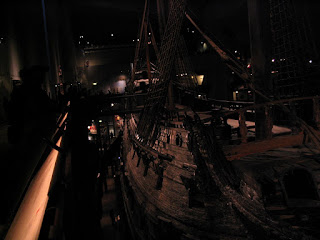Today I visited the Vasa Museet in Stockholm, Sweden. I have to reflect upon museums in general after visiting this museum, the one place in Stockholm everyone told us we couldn't miss. Upon entering the Vasa your eyes adjust to the manufactured darkness and mystery, and you are greeted with an impossibly large, nearly ghostly wooden ship. It is the reconstructed remains of a 333 year old war ship built by Gustof Adolfus in his war against Poland. It, unfortunately, never made it out of Stockholm harbor, as it was poorly balanced and blew over in the wind the first time its sails caught a full gust. The ship was salvaged in the 1960s, and painstakingly preserved before being towed into a building built specifically for the purpose. Quite the feat. However, after walking through the doors, letting my eyes adjust and having that one heart-stopping moment of seeing a huge, neatly displayed ship in front of me, I was at a loss for what exactly I was supposed to do in this museum. I mean, I know I was supposed to read all about the sinking and the salvaging, watch their little documentary, and generally educate myself about this great bio-historical-engineering coup-de-gras, but it wasn't obvious what was important about this, or why I should do this after the initial 'wow' moment. My instinct here, is that the Vasa museum put a lot of time/ effort/ money (the holly trinity in public works) into manufacturing the experience I had when I walked in the door, and not a lot into what comes afterward. I am very familiar with the emphasis placed on the 'wow' moment by museum practitioners, but I also wonder if its over emphasis is at the detriment of a more robust experience. This is, of course, dependent on our definition of an 'experience.' The wow moment is definitely a type of experience, but it does not necessarily add anything to one's ability to contribute to a more just, democratic society. What then could a museum like the Vasa do to reconstruct the sorts of experiences it offers? My sense is that this is highly dependent on the design of the museum, and not just something that can be tweaked after-the-fact. What an artifact like the Vasa has to offer a social project of education is a different question than what it has to offer as an object of amazement. I do not posit that these two things are un-related, but it seems quite clear to me that one is more than the other, while at the same time evasive of generalization, which is the fundamental problem in most attempts at public education.
Monday, October 1, 2007
Subscribe to:
Post Comments (Atom)

6 comments:
and then....?
I found the Vasa museum amazing and memorable - as it is. Having visited it twice when in Stockholm, I would recommend it highly to anyone.
Not a very compelling argument. A museum is meant to wow and then educate. If you take the opportunity to read all that the museum has to offer then that is exactly what happens. The Vasa (not Vassa) is an amazing ship, an amazing story, and an amazing historical artifact.
the hairy swede makes an interesting point, "if you take the opportunity to read all the that the museum has to offer then . . . the Vasa is an amazing ship, an amazing story, and an amazing historical artifact." While I am not disputing any of those things, I am interested in why that is inherently 'good' thing? Why is it to be assumed that being wowed by an "amazing ship, an amazing story, and an amazing historical artifact" enough? What else is there for museums to be responsible for? Again, I'll reiterate that those things are not bad things, or even unrelated, or unimportant things, they just aren't everything I'd like to see museums doing, and I believe other opportunities often suffer when so much energy is put into "wow."
Good words.
Post a Comment